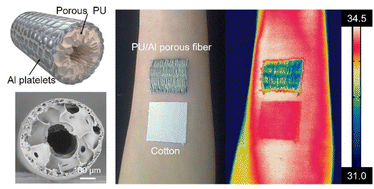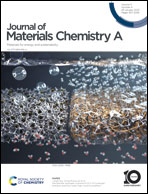Bioinspired hollow porous fibers with low emissivity and conductivity aluminum platelet skin for thermal insulation†
Abstract
Traditional porous aerogel fibrous textiles are commonly used for personal thermal insulation, owing to their low thermal conductivity. However, lot of heat will dissipate to the environment via infrared (IR) radiation when human body heat transfers to textiles via conduction. Although some metallic materials with low IR emissivity are used to reduce the IR-induced heat loss, high thermal conductivity, high cost and poor wearability limit their application in textiles. Therefore, it remains a great challenge to realize personal thermally insulating materials through simultaneous low thermal conductivity and low IR emissivity to maximally reduce heat loss. Here, inspired by sunlight shielding Saharan silver ant hairs and thermally insulating polar bear hairs, we present a coaxial wet spinning strategy to produce elastic hollow porous polyurethane fibers with reflective thin aluminum platelet skin. The textile presents thermal insulation properties through low thermal conductivity (∼0.049 W m−1 K−1) and IR emissivity (∼0.36). This work provides a promising direction for developing the next generation of high-performance thermal insulation fiber textiles, providing people with warmer microclimates and decreasing depletion of resources to achieve global sustainable development.

- This article is part of the themed collection: Journal of Materials Chemistry A HOT Papers


 Please wait while we load your content...
Please wait while we load your content...